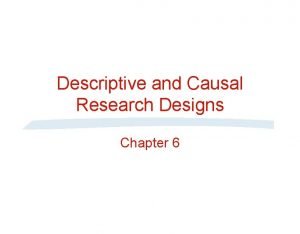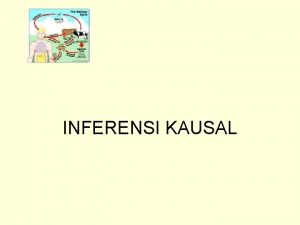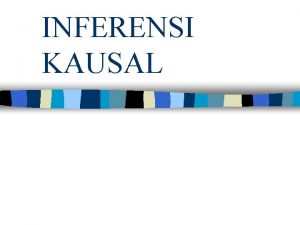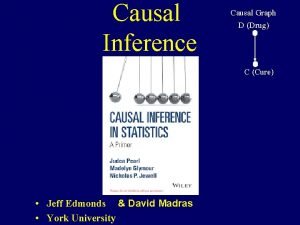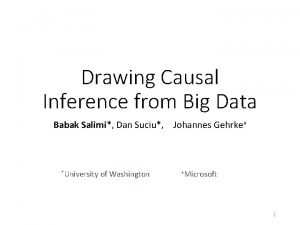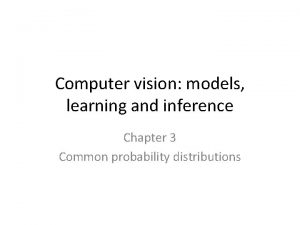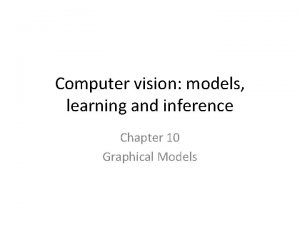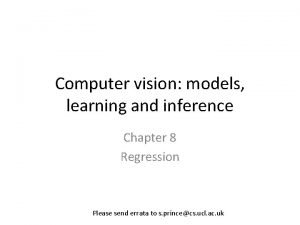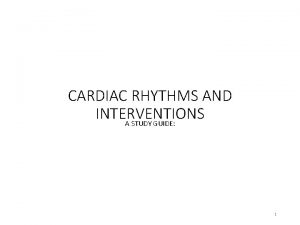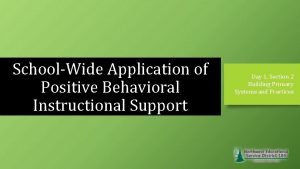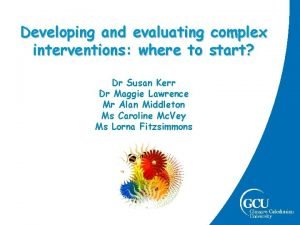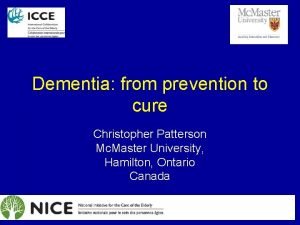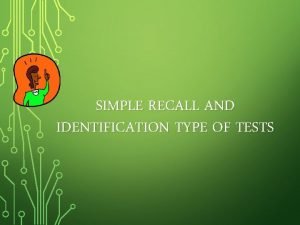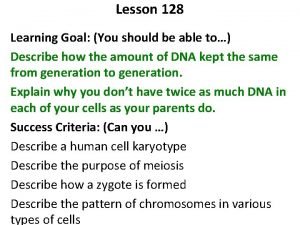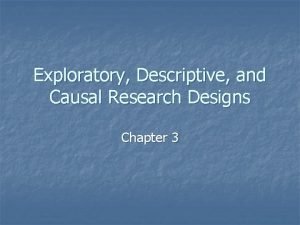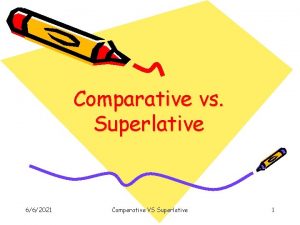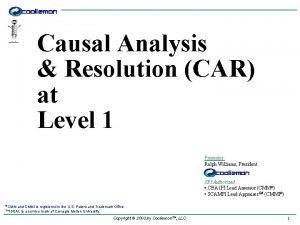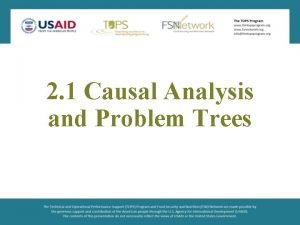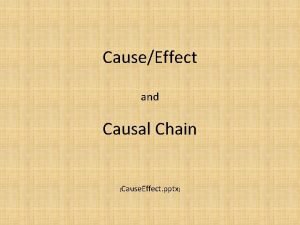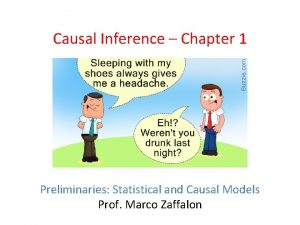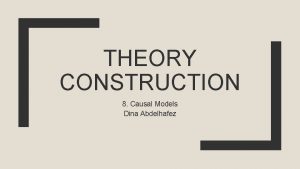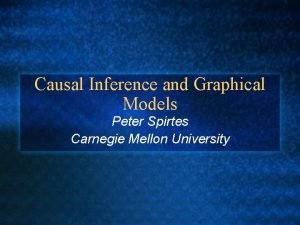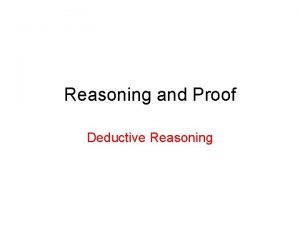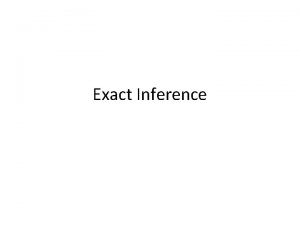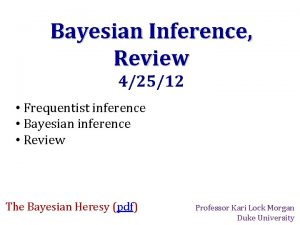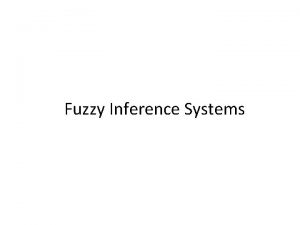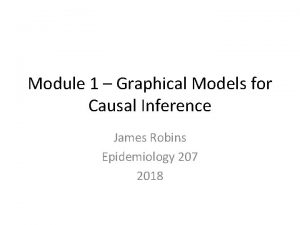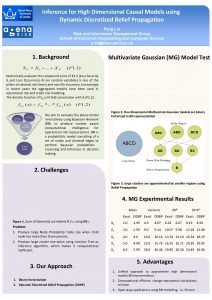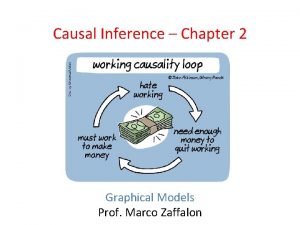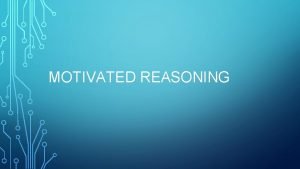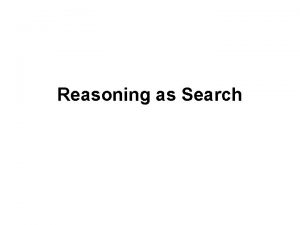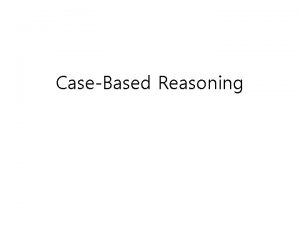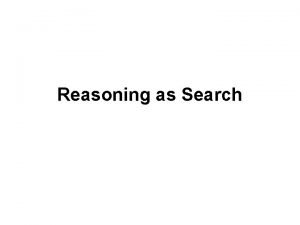INTERVENTIONS AND INFERENCE REASONING Causal models Recall from

































- Slides: 33

INTERVENTIONS AND INFERENCE / REASONING

Causal models Recall from yesterday: Represent relevance using graphs Causal relevance ⇒ DAGs Quantitative component = joint probability distribution And so clear definitions for independence & association Connect Markov: DAG & jpd with two assumptions: No edge ⇒ Independent given direct parents Faithfulness: Conditional independence ⇒ No edge

Three uses of causal models Represent (and predict the effects of) interventions on variables Causal models only, of course Efficiently determine independencies I. e. , which variables are informationally relevant for which other ones? Use those independencies to rapidly update beliefs in light of evidence

Representing interventions Central intuition: When we intervene, we control the state of the target variable And so the direct causes of the target variable no longer matter But the target still has its usual effects Directly applying current to the light bulb ⇒ light switch doesn’t matter, but the plant still grows

Representing interventions Formal implementation: Add a variable representing the intervention, and make it a direct cause of the target When the intervention is “active, ” remove all other edges into the target Leave intact all edges directed out of the target, even when the intervention is “active”

Representing interventions Example: Light Switch Light Bulb Plant Growth

Representing interventions Example: Add a manipulation variable as a “cause” Current Light Switch Light Bulb Plant Growth

Representing interventions Example: Add a manipulation variable as a “cause” that does not matter when it is inactive Current Light Switch Inactive Light Bulb Plant Growth Inactive Manipulation

Representing interventions Example: Add a manipulation variable as a “cause” that does not matter when it is inactive When it is active, Current Light Switch Inactive Light Bulb Plant Growth Inactive Manipulation Current Light Switch Light Bulb Plant Growth Active Manipulation

Representing interventions Example: Add a manipulation variable as a “cause” that does not matter when it is inactive When it is active, break the incoming edges, but leave the outgoing edges Current Light Switch Inactive Light Bulb Plant Growth Inactive Manipulation Current Light Switch Light Bulb Plant Growth Active Manipulation

Representing interventions Straightforward extension to more interesting types of interventions Interventions away from current state Multi-variate interventions Etc. Key: For all of these, the “intervention operator” takes a causal graphical model as input, and yields a causal graphical model as output “Post-intervention CGM” is an ordinary CGM

Why randomize? Standard scientific practice: randomize Treatment to find its Effects E. g. , don’t let people decide on their own whether to take the drug or placebo What is the value of randomization? Randomization is an intervention All edges into T will be broken, including from any common causes of T and E! ⇒ If T E, then we must have: T → E ⇒

Why randomize? Graphically, Treatment ? Effect

Why randomize? Graphically, Treatment ? Unobserved Factors Effect

Why randomize? Graphically, Treatment ? Unobserved Factors Effect

Why randomize? Graphically, Treatment ? Unobserved Factors Effect

Why randomize? Graphically, Treatment ? Unobserved Factors Effect

Three uses of causal models Represent (and predict the effects of) interventions on variables Causal models only, of course Efficiently determine independencies I. e. , which variables are informationally relevant for which other ones? Use those independencies to rapidly update beliefs in light of evidence

Determining independence Markov & Faithfulness ⇒ DAG structure determines all statistical independencies and associations Graphical criterion: d-separation X and Y are independent given S iff X and Y are d-separated given S iff X and Y are not d-connected given S Intuition: X and Y are d-connected iff information can “flow” from X to Y along some path

d-separation C is a collider on a path iff A → C ← B Formally: A path between A and B is active given S iff Every non-collider on the path is not in S; and Every collider on the path is either in S, or else one of its descendants is in S X and Y are d-connected by S iff there is an active path between X and Y given S

d-separation Surprising feature being exploited here: Conditioning on a common effect induces an association between independent causes Motivating example: Gas Tank → Car Starts ← Spark Plugs Gas and Plugs are independent, but if we know that the car doesn’t start, then they’re associated And In that case, learning Gas = Full changes the likelihood that Plugs = Bad similarly if Car Starts → Emits Exhaust

d-separation Algorithm to determine d-separation: Write down every path between X and Y 1. – – – Edge direction is irrelevant for this step Just write down every sequence of edges that lies between X and Y But don’t use a node twice in the same path

d-separation Algorithm to determine d-separation: Write down every path between X and Y For each path, determine whether it is active by checking the status of each node on the path 1. 2. The node is not active if either: – – 1. 2. 1. N is a collider + not in S (and no descendants of N are in S); or N is not a collider and in S. I. e. , “multiply” the “not”s to get the node status Any node not active ⇒ path not active

d-separation Algorithm to determine d-separation: 1. 2. 3. Write down every path between X and Y For each path, determine whether it is active by checking the status of each node on the path Any path active ⇒ d-connected ⇒ X & Y associated No path active ⇒ d-separated ⇒ X & Y independent

d-separation Exercise and Weight given Metabolism? E →M→W Food Eaten Blocked! M is an included non-collider E → FE → W Exercise FE is a non-included non-collider Weight Unblocked! ⇒E W|M Metabolism

d-separation Metabolism and FE given Exercise? M → W ← FE Food Eaten Blocked! W is a non-included collider M ← E → FE E is an included non-collider Exercise Weight Blocked! ⇒M FE | E Metabolism

d-separation Metabolism and FE given Weight? M → W ← FE Food Eaten Unblocked! W is an included collider M ← E → FE Exercise E is a non-included non-collider Weight Unblocked! ⇒M FE | W Metabolism

Updating beliefs For both statistical and causal models, efficient computation of independencies ⇒ efficient prediction from observations Specific instance of belief updating Typically, “just” compute conditional probabilities Significantly easier if we have (conditional) independencies, since we can ignore variables

Bayes (and Bayesianism) Bayes’ Theorem: proof is trivial… Interpretation is the interesting part: Let D be the observation and T be our target variable(s) of interest ⇒ Bayes’ theorem says how to update our beliefs about T given some observation(s)

Bayes (and Bayesianism) Terminology: Likelihood function Prior distribution Posterior distribution Data distribution

Bayes and independence Knowing independencies can greatly speed Bayesian updating P(C | E, F, G) = [complex mess] Suppose C independent of F, G given E ⇒ P(C | E, F, G) = P(C | E) = [something simpler]

Updating beliefs Compute: P(M = Hi | E = Hi, FE = Lo) FE M|E ⇒ P(M | E, FE) = P(M | E) And P(M | E) is a term in the Markov factorization! Exercise Food Eaten Weight Metabolism

Looking ahead… Have: Basic formal representation for causation Fundamental causal asymmetry (of intervention) Inference & reasoning methods Need: Search & causal discovery methods
 Exploratory, descriptive and causal research
Exploratory, descriptive and causal research Inferensi kausal
Inferensi kausal Causal inference techniques
Causal inference techniques Causal inference vs correlation
Causal inference vs correlation Babak salimi
Babak salimi Avoiding discrimination through causal reasoning
Avoiding discrimination through causal reasoning Computer vision models learning and inference
Computer vision models learning and inference Computer vision: models, learning, and inference
Computer vision: models, learning, and inference Computer vision models learning and inference pdf
Computer vision models learning and inference pdf Computer vision: models, learning, and inference
Computer vision: models, learning, and inference Deductive and inductive reasoning
Deductive and inductive reasoning Inductive reasoning examples
Inductive reasoning examples Inductive reasoning vs deductive reasoning
Inductive reasoning vs deductive reasoning Deductive reasonign
Deductive reasonign Inductive reasoning vs deductive reasoning
Inductive reasoning vs deductive reasoning Deductive vs inductive geometry
Deductive vs inductive geometry Inductive reasoning patterns
Inductive reasoning patterns What is the difference between models & semi modals?
What is the difference between models & semi modals? Cardiac rhythms and interventions
Cardiac rhythms and interventions Positive behavioral interventions and supports
Positive behavioral interventions and supports Positive behavioral interventions and supports
Positive behavioral interventions and supports Developing and evaluating complex interventions
Developing and evaluating complex interventions Dementia treatments and interventions near patterson
Dementia treatments and interventions near patterson Information retrieval evaluation
Information retrieval evaluation Difference between recall and recognition
Difference between recall and recognition Identification type of test example
Identification type of test example Active recall and spaced repetition
Active recall and spaced repetition Exploratory vs descriptive vs causal research
Exploratory vs descriptive vs causal research Correlational research
Correlational research Comperative
Comperative Causal analysis and resolution
Causal analysis and resolution Causal tree analysis
Causal tree analysis Non conclusive research design
Non conclusive research design Cause and effect causal chain examples
Cause and effect causal chain examples
